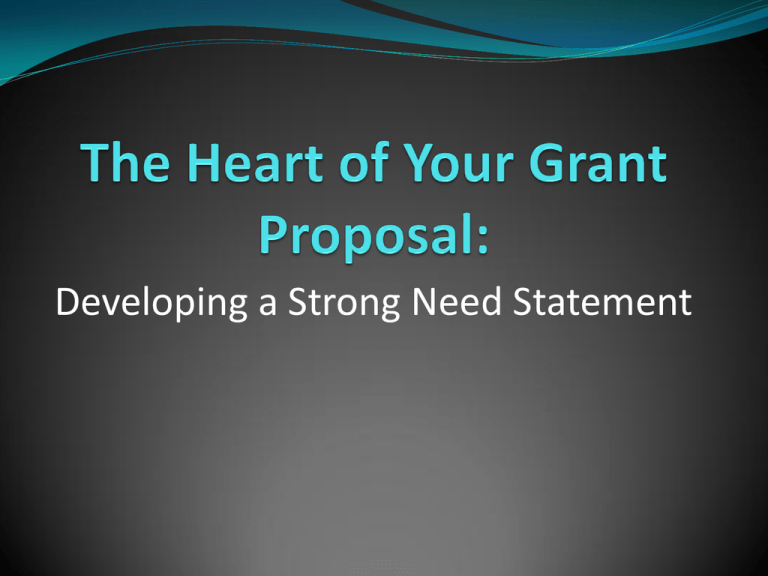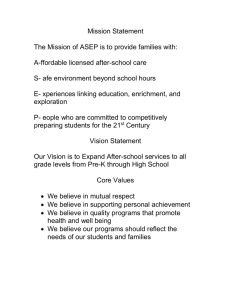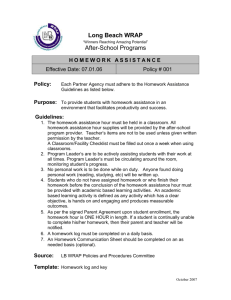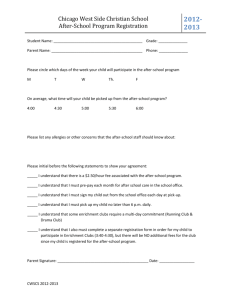Developing a Strong Need Statement
advertisement

Developing a Strong Need Statement Statement of Need Also known as problem statement, need statement, or needs assessment Statement of need establishes the focus and rationale for the grant proposal or project Statement of Need If you do not have a compelling need, you do not have a compelling project The statement of need is a concise and coherent statement, supported by evidence, on why the project needs to be undertaken The statement of need drives everything else that is in the grant proposal General Rules Don’t use jargon Spell out acronyms Don’t assume reviewer knows about the conditions that prompted the project Don’t editorialize—state facts Need should be based on rational terms, not on emotional appeals General Rules Avoid circular reasoning (stating the absence of your solution as the problem) For example: “The problem is that we have no youth center. The solution is to build a youth center.” General Rules How do you know that the absence of a youth center is a problem? What kind of evidence (data) do you have to back that up? Remember: Your solution is not your problem General Rules Make sure statement of need is locally based and focused The need/problem may be a national problem as well, but make sure that you establish that it is a local problem through relevant data Don’t assume that a national problem is automatically a local problem General Rules Like your whole grant proposal, your statement of need should be: Concise (stick to the main points) Complete (include everything asked for) Coherent (provide a logical case for your need/problem) Statement of Need Statement of need should answer the following questions: Statement of Need What is the problem/need? How do you know it is a problem? Statement of need should be supported by evidence (qualitative or quantitative data) The data should be current, not out-of-date Statement of Need Sources of statistics on the internet: www.census.gov www.fedstats.gov Statement of Need Other sources of data collection: Surveys/need assessments Local colleges/universities Regional Planning/Development Councils Local library Statement of Need Always use comparative data For example: “The poverty rate in Acme County is 15%” (Nothing to compare the county rate with) Comparative: “The poverty rate in Acme County is 15%, compared with 12% in the state and 12.5% nationally” Statement of Need What is the target population that you are trying to help? Describe the target population and the needs/conditions of that population Statement of Need Don’t confuse your organization’s needs with the needs of your target population Funders do not fund your organization’s needs, they fund what your organization can do to help your community Don’t forget: The need is in your community/region, show the impact there Statement of Need Is the problem/need urgent? Why does it need to be addressed now? Statement of Need Why should it be your organization that addresses the problem/need? Make sure that the problem/need relates to the purpose and mission of your organization (and state this in your proposal) Recap on Four Questions What is the need/problem? How do you know it is a need/problem? What is the target population that you are trying to help? Is the problem/need urgent? Why does it need to be addressed now? Why should it be your organization that addresses the problem/need? Statement of Need (Examples) “Our youth have limited access to educational resources. They are mostly from low-income households, and the neighborhood in general is very distressed. We have one after-school program that is well attended, but we need more resources to reach more of our students. Please help us educate our youth.” Statement of Need (Examples) Problems with this statement of need: No data or evidence Emotional appeal rather than rational How do you know that they are “mostly” from low-income households? How do you know the neighborhood “in general” is distressed? Statement of Need (Examples) “According to the National Acme Education Center, 45% of middle school students across the nation do not have access to after-school programs, and in our state the figure rises to 58%. The same source also pointed out that our state education budget is being cut by 12%. These are trends that the students in our community must be able to overcome.” Statement of Need (Examples) Problems with this statement of need: Does not focus on local conditions (is there an after-school program or other resources in the community?) Conclusion Statement of need should be backed up by evidence Use comparative data Watch for circular reasoning Don’t confuse your needs with your target population’s needs Be concise and localize your need



